2018 MERCEDES-BENZ S-CLASS SEDAN sensor
[x] Cancel search: sensorPage 22 of 562

*NO
TEImpairment of the operating ef fi‐
ciency of there stra int sy stems from
ins talling accessories or from repairs or
we lding
Airbags, Emer gency Tensioning Devices, as
we ll as control units and sensors forth e
re stra int sy stems, may be ins talled in thefo l‐
lowing areas of your vehicle:
RDoors
RDoor pillars
RDoor sills
RSeats
RCo ckpit
RInstrument clus ter
RCente r console
#Do not ins tall accessories such as audio
sy stems in these areas.
#Do not car ryout repairs or welding.
#Have accessori esretrofitted at a quali‐
fi ed specialist workshop.
Yo u could jeopardize the operating saf etyof your
ve hicle if you use parts, tires and wheels as well
as accessories releva nt tosaf etywhic hha ve not
been appr ovedby Mercedes-Benz. Saf ety-re le‐
va nt sy stems, e.g. the brake sy stem, may mal‐
function. Only use Mercedes-Benz GenuineParts
or parts of equal quality. Only use tires, wheels
and accessory parts that ha vebeen specifically
appr ovedfo ryo ur vehicle model.
Mercedes-Benz GenuineParts are subject to
st rict quality control. Each part has been spe‐
cially de veloped, manufactured or selecte dfo r
Mercedes-Benz vehicles and fine-tuned forth em.
Therefore, only Mercedes-Benz GenuineParts
should be used.
More than 300,000 dif fere nt Mercedes-Benz
GenuineParts are available for Mercedes-Benz
models.
All au thorized Mercedes-Benz Centers maintain
a supply of Mercedes-Benz GenuineParts for
necessary service and repair work. In addition,
st ra tegically located parts-delivery centers pro‐
vide forqu ick and reliable parts service. Alw
ays specify theve hicle identification number
(VIN) (→page 445) when orde ring Mercedes-
Benz GenuineParts.
Ope rato r's Manual
This Operator's Manual describes all models and
all standard and optional equipment available for
yo ur vehicle at the time of this Opera tor's Man‐
ual going topress. Countr y-specific dif fere nces
are possible. No tethat your vehicle may not be
equipped with all features descri bed. This also
applies tosaf ety-re leva nt sy stems and functions.
Therefore, the equipment on your vehicle may
dif fer from that in the descriptions and illustra‐
tions.
The original pur chase contract documentation
fo ryo ur vehicle contains a list of all of the sys‐
te ms in your vehicle.
Should you ha veany questions concerning
equipment and operation, please consult an
authorized Mercedes-Benz Center.
The Operator's Manual and Maintenance Booklet
are impor tant documents and should be kept in
th eve hicle.
20
General no tes
Page 29 of 562

Rstatus messages concerning theve hicle and
its individual components (e.g. number of
wheel revo lutions/speed, decele ration, lat‐
eral acceleration, display of thefast ened seat
belts)
Rmalfunctions or defects in impor tant sy stem
components (e.g. lights, brakes)
Rinformation on vehicle damage events
Rsystem reactions in special driving situations
(e.g. air bag deployment, inter vention of sta‐
bility control sy stems)
Rambient conditions (e.g. temp erature, rain
sensor)
In addition toprov iding the actual control unit
function, this data assists the manufacturer in
de tecting and rectifying malfunctions and opti‐
mizing vehicle functions. The majority of this
data is temp orary and is only processed in the
ve hicle itself. Only a small portion of the data is
st ored in theev ent or malfunction memor y.
When your vehicle is serviced, tech nical da ta
from theve hicle can be read out byservice net‐
wo rkemplo yees or third parties. Services
include repair services, maintenance processes, wa
rranty events and quality assurance meas‐
ures, forex ample. The read out is per form ed via
th e legally prescribed port for OBD ("on-board
diagnostics") in theve hicle. The respective
service network locations or third parties col‐
lect, process and use the data. They document
te ch nical statuses of theve hicle, assist in
find
‐
ing malfunctions and impr oving quality and are
transmitte dto the manufacturer, if necessar y.
Fu rthermore, the manufacturer is subject to
product liability. Forth is, the manufacturer
re qu ires tech nical da tafrom vehicles.
Malfunction memories in theve hicle can be
re set bya service outlet as part of repair or
maintenance work.
They can enter data into theve hicle's con veni‐
ence and inf otainment functions themselves as
part of the selected equipment.
This includes, forex ample:
Rmultimedia data such as music, films or pho‐
to sfo r playba ckin an integrated multimedia
sy stem
Raddress book data for use in connection with
an integrated hands-free sy stem or an inte‐
grated navigation sy stem
Rentered navigation destinations
Rdata about the use of Internet services
This data can be stored locally in theve hicle or
is located on a device which you ha veconnected
to theve hicle. If this data is stored in theve hi‐
cle, you can dele teit at any time. This data can
only be transmitte dto third parties upon your
re qu est with particular rega rd tothe scope of
use of online services according to your selected
settings.
Yo u can store or change con venience settings/
individualization in theve hicle at any time.
Depending on the eq uipment,
this in
cludes,for
ex ample:
Rseat and steering wheel position settings
Rsuspension and climate control settings
Rindividualization such as interior lighting
If yo ur vehicle is accordingly equipped, you can
connect your smartphone or ano ther mobile end
General no tes 27
Page 34 of 562

Restra int sy stem functionality
When the ignition is switched on, a sy stem self-
te st is per form ed, during which the6
re stra int sy stem warning lamp lights up. It goes
out no later than a few seconds af terth eve hicle
is star ted. The components of there stra int sys‐
te m are then functional.
Malfunctioning restra int sy stem
A malfunction has occur red in there stra int sys‐
te m if:
RThe 6 restra int sy stem warning lamp
does not light up when the ignition is
switched on.
RThe 6 restra int sy stem warning lamp
lights up continuously or repeatedly during a
journe y.
&
WARNING Risk of injury orfata l injury
due toa malfunction in there stra int sys‐
te m
If th ere stra int sy stem is malfunctioning,
re stra int sy stem components may be trig‐
ge red unintentionally or might not be trig‐
ge red at all in theeve nt of an accident. This
may af fect the Emer gency Tensioning Device
or airbag, forex ample.
#Ha ve there stra int sy stem checked and
re paired immediately at a qualified spe‐
cialist workshop.
Fu nction of there stra int sy stem in an acci‐
dent
How there stra int sy stem works is de term ined by
th e se verity of the impact de tected and the type
of accident anticipated:
RFr ontal impact
RRe ar impact
RSide impact
RRo llover The activation
thre sholds forth e components of
th ere stra int sy stem are de term ined based on
th eev aluation of the sensor values measured at
va rious points in theve hicle. This process is pre-
em ptive in nature. The triggering/deployment of
th e components of there stra int sy stem should
ta ke place in good time at thest art of the colli‐
sion.
Fa ctors whi chcan only be seen and measure d
af te r a collision has occur red cann otplay a deci‐
sive role in air bag deployment, nor do they pro‐
vide an indication of air bag deployment.
The vehicle may be deformed significantly with‐
out an air bag being deplo yed. This is the case if
only parts which are relatively easily deformed
are af fected and thera te ofvehicle deceleration
is not high. Con versely, an air bag may be
deplo yedev en though theve hicle suf fers only
minor deformation. If very rigid vehicle parts
such as longitudinal members are hit, forex am‐
ple, theve hicle deceleration may be high enough
fo rth is to happen.
32
Occupant saf ety
Page 43 of 562
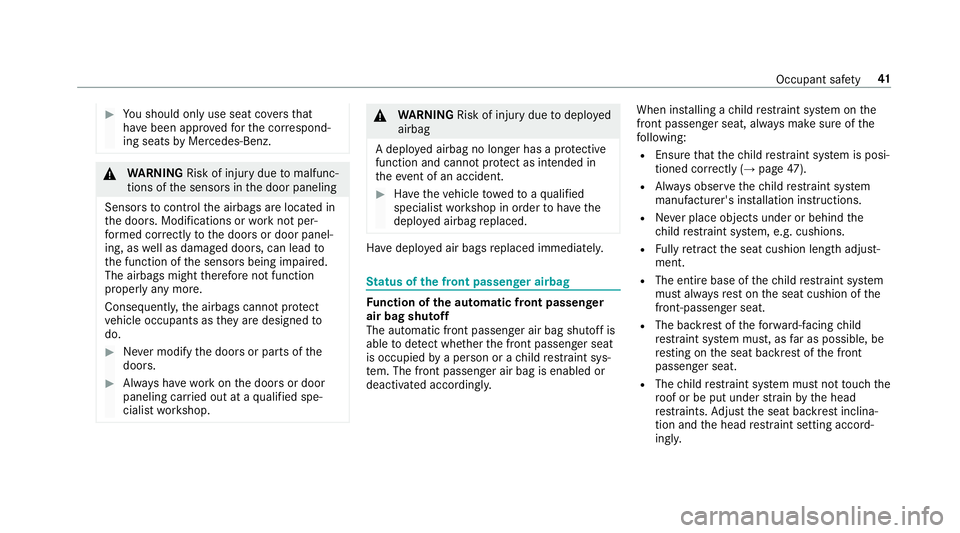
#You should only use seat covers that
ha ve been appr oved forth e cor respond‐
ing seats byMercedes-Benz.
&
WARNING Risk of injury duetomalfunc‐
tions of the sensors in the door paneling
Sensors tocontrol the airbags are located in
th e doors. Modifications or worknot per‐
fo rm ed cor rectly tothe doors or door panel‐
ing, as well as damaged doors, can lead to
th e function of the sensors being impaired.
The airbags might therefore not function
proper lyany more.
Consequent ly,th e airbags cannot protect
ve hicle occupants as they are designed to
do.
#Ne ver modify the doors or parts of the
doors.
#Alw ays ha vewo rkon the doors or door
paneling car ried out at a qualified spe‐
cialist workshop.
&
WARNING Risk of injury duetodeplo yed
airbag
A deplo yed airbag no longer has a pr otective
function and cann otprotect as intended in
th eev ent of an accident.
#Ha ve theve hicle towe dto aqu alified
specialist workshop in order tohave the
deplo yed airbag replaced.
Ha ve deplo yed air bags replaced immediately.
St atus of the front passenger airbag
Fu nction of the automatic front passenger
air bag shuto ff
The automatic front passenger air bag shutoff is
able todetect whe ther the front passenger seat
is occupied bya person or a child restra int sys‐
te m. The front passenger air bag is enabled or
deactivated accordingly. When ins
talling a child restra int sy stem on the
front passenger seat, alw ays make sure of the
fo llowing:
REnsure that thech ild restra int sy stem is posi‐
tioned cor rectly (→page 47).
RAlw ays obser vethech ild restra int sy stem
manufacturer's ins tallation instructions.
RNe ver place objects under or behind the
ch ild restra int sy stem, e.g. cushions.
RFu lly retract the seat cushion length adjust‐
ment.
RThe entire base of thech ild restra int sy stem
must alw aysre st on the seat cushion of the
front-passenger seat.
RThe backrest of thefo rw ard-facing child
re stra int sy stem must, as far as possible, be
re sting on the seat backrest of the front
passenger seat.
RThe child restra int sy stem must not touch the
ro of or be put under stra in by the head
re stra ints. Adjust the seat backrest inclina‐
tion and the head restra int setting accord‐
ing ly.
Occupant saf ety 41
Page 65 of 562
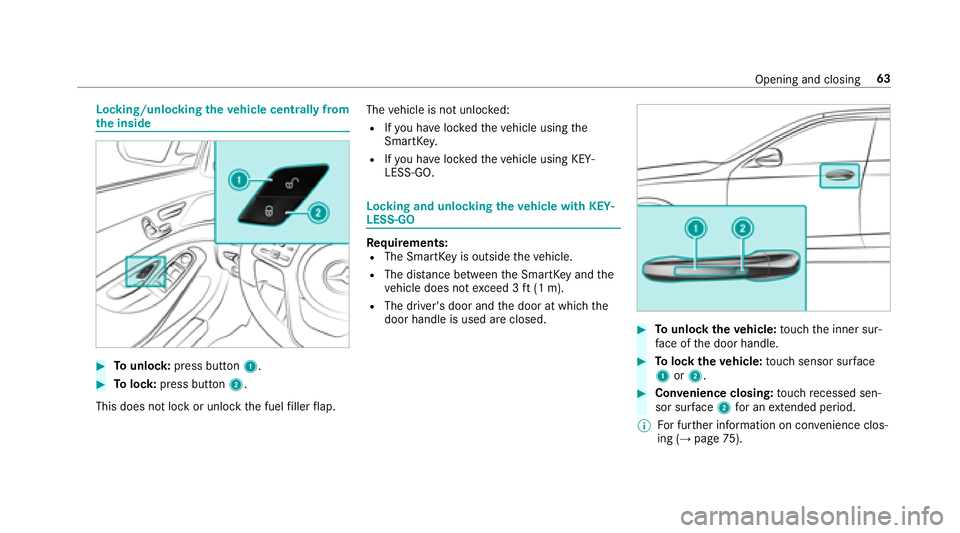
Locking/unlockingtheve hicle centrally from
th e inside
#To unlock :press button 1.
#Tolock: press button 2.
This does not lock or unlock the fuel filler flap. The
vehicle is not unloc ked:
RIfyo u ha veloc kedth eve hicle using the
SmartK ey.
RIfyo u ha veloc kedth eve hicle using KEY‐
LESS-GO.
Locking and unlocking theve hicle with KEY‐
LESS-GO
Requ irements:RThe SmartK eyis outside theve hicle.
RThe dis tance between the SmartK eyand the
ve hicle does not exceed 3 ft(1 m).
RThe driver's door and the door at which the
door handle is used are closed.
#To unlock theve hicle: touch the inner sur‐
fa ce of the door handle.
#To lock theve hicle: touch sensor sur face
1 or2.
#Co nvenience closing: touch recessed sen‐
sor surf ace2for an extended pe riod.
% For fur ther information on con venience clos‐
ing (
→pa ge 75).
Opening and closing 63
Page 71 of 562
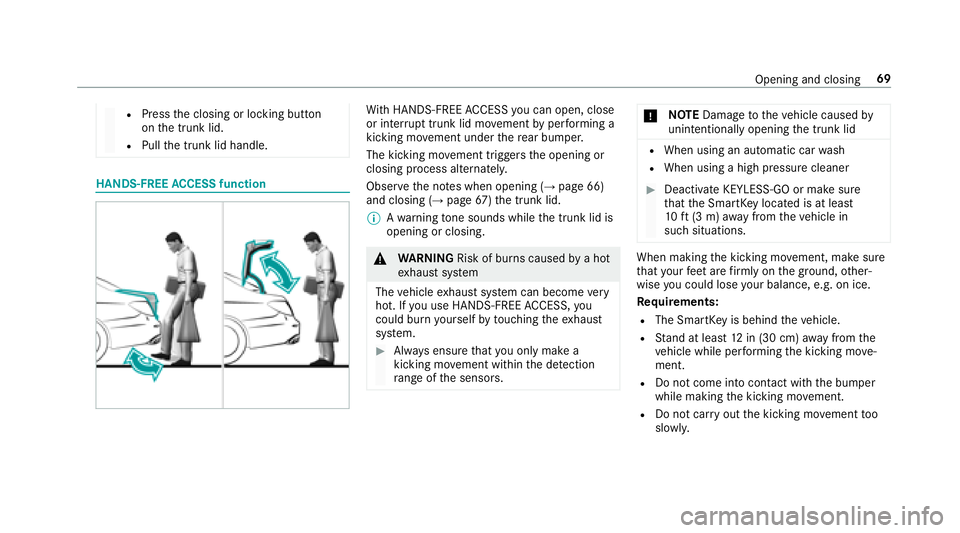
RPressthe closing or locking button
on the trunk lid.
RPull the trunk lid handle.
HANDS-FREE ACCESS function
With HANDS-FREE ACCESS you can open, close
or inter rupt trunk lid mo vement byper form ing a
kicking mo vement under there ar bumper.
The kicking mo vement triggers the opening or
closing process alternately.
Obser vethe no tes when opening (
→page 66)
and closing (→page 67)th e trunk lid.
% Awa rning tone sounds while the trunk lid is
opening or closing.
& WARNING Risk of burn s causedbya hot
ex haust sy stem
The vehicle exhaust sy stem can become very
hot. If you use HANDS- FREEACCESS, you
could burn yourself by touching theex haust
sy stem.
#Alw ays ensure that you only ma kea
kicking mo vement within the de tection
ra nge of the sensors.
* NO
TEDama getotheve hicle caused by
unin tentional lyopening the trunk lid
RWhen using an automatic car wash
RWhen using a high pressure cleaner
#Deactivate KEYLESS-GO or make sure
that the SmartK eylocated is at least
10 ft(3 m) away from theve hicle in
such situations.
When making the kicking mo vement, make sure
th at your feet are firm ly on the ground, other‐
wise you could lose your balance, e.g. on ice.
Re quirements:
RThe SmartK eyis behind theve hicle.
RStand at least 12in (30 cm) away from the
ve hicle while per form ing the kicking mo ve‐
ment.
RDo not come into contact with the bumper
while making the kicking mo vement.
RDo not car ryout the kicking mo vement too
slowl y.
Opening and closing 69
Page 72 of 562
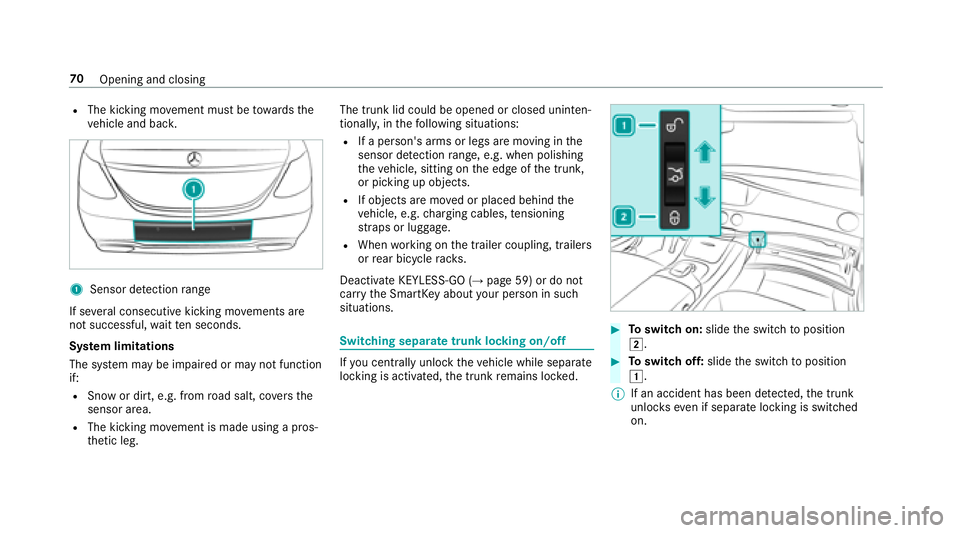
RThe kicking movement must be towa rdsth e
ve hicle and bac k.
1Sensor detection range
If se veral consecutive kicking mo vements are
not successful, waitte n seconds.
Sy stem limitations
The sy stem may be impaired or may not function
if:
RSnow or dirt, e.g. from road salt, co vers the
sensor area.
RThe kicking mo vement is made using a pros‐
th etic leg. The trunk lid could be opened or closed unin
ten‐
tional ly, in thefo llowing situations:
RIf a person's arms or legs are moving in the
sensor de tection range, e.g. when polishing
th eve hicle, sitting on the edge of the trunk,
or picking up objects.
RIf objects are mo ved or placed behind the
ve hicle, e.g. charging cables, tensioning
st ra ps or luggage.
RWhen working on the trailer coupling, trailers
or rear bicycle rack s.
Deactivate KEYLESS-GO (
→page 59) or do not
car rythe SmartK eyabout your person insuch
situations.
Switch ing separate trunk locking on/off
Ifyo u centrally unlo cktheve hicle while separate
locking is activated, the trunk remains loc ked.
#To switch on: slidethe switch toposition
2.
#To switch off: slidethe switch toposition
1.
% If an accident has been de tected, the trunk
unloc kseve n if separate lo cking is switched
on.
70 Opening and closing
Page 148 of 562
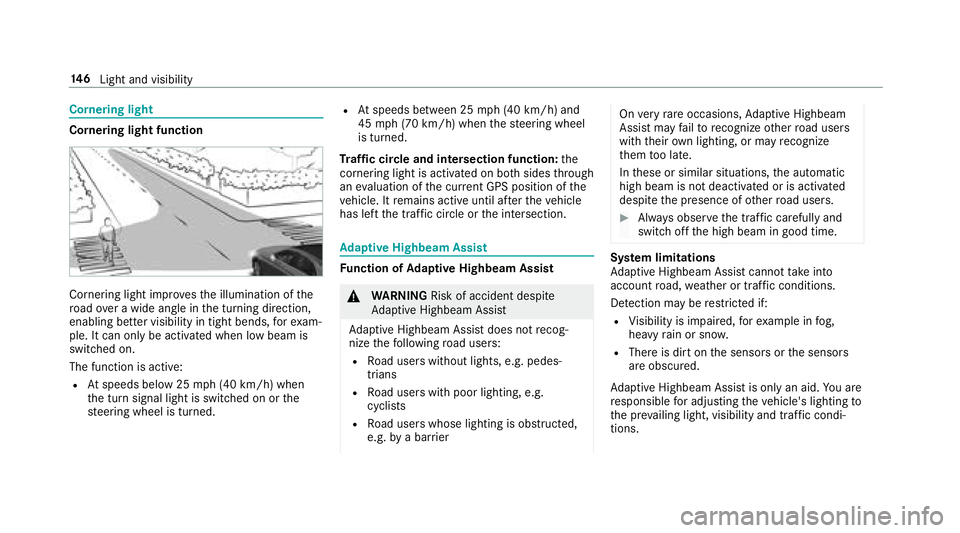
Cornering light
Cornering light function
Cornering light improvesth e illumination of the
ro ad ove r a wide angle in the turning direction,
enabling better visibility in tight bends, forex am‐
ple. It can only be activated when low beam is
switch ed on.
The function is active:
RAt speeds below 25 mph (40 km/h) when
th e turn signal light is switched on or the
st eering wheel is turned.
RAt speeds between 25 mph (40 km/h) and
45 mph (70 km/h) when thesteering wheel
is turned.
Tr af fic circle and intersection function: the
cornering light is acti vated on bo thsides thro ugh
an evaluation of the cur rent GPS position of the
ve hicle. It remains active until af terth eve hicle
has left the traf fic circle or the intersection.
Ad aptive Highbeam Assist
Function of Adaptive Highbeam Assist
&
WARNING Risk of accident despite
Ad aptive Highbeam Assist
Ad aptive Highbeam Assist does not recog‐
nize thefo llowing road users:
RRo ad users without lights, e.g. pedes‐
trians
RRo ad users with poor lighting, e.g.
cyclists
RRo ad users whose lighting is obstructed,
e.g. bya bar rier
On very rare occasions, Adaptive Highbeam
Assist may failto recognize other road users
with their own lighting, or may recognize
th em too late.
In these or similar situations, the automatic
high beam is not deactivated or is activated
despite the presence of other road users.
#Alw ays obser vethe tra ffic carefully and
switch off the high beam in good time.
Sy stem limitations
Ad aptive Highbeam Assist cannot take into
account road, weather or traf fic conditions.
De tection may be restricted if:
RVi sibility is impaired, forex ample in fog,
heavy rain or sno w.
RThere is dirt on the sensors or the sensors
are obscured.
Ad aptive Highbeam Assist is only an aid.You are
re sponsible for adju sting theve hicle's lighting to
th e pr evailing light, visibility and traf fic condi‐
tions.
14 6
Light and visibility